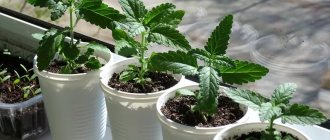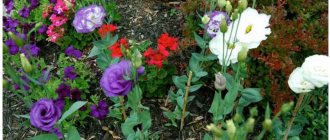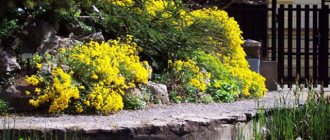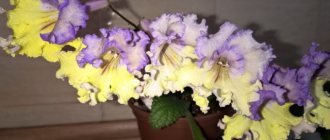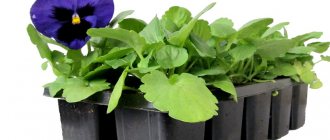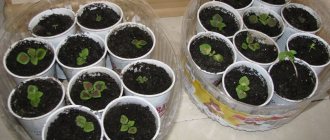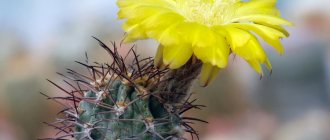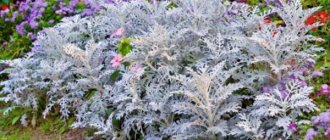Verbena is a flower that has been grown by more than one generation of amateur gardeners. In addition to the fact that this is a beautiful plant, it is also useful (Verbena officinalis), and is quite easy to grow. In nature, there are about 120 species of this plant. Among them there are both annual and perennial species, there are also semi-shrubs and creeping ones, which we readily grow as hanging plants. Verbena is often called “Pigeon Grass” among the people. I have never found a clear explanation for this name. But verbena is credited with a great many different magical properties - from kindling love to the ability to open locks and constipation.
She was revered by the Druids, the ancient Greeks and Romans, and she is also revered by Christians. It is believed that it is watered with the blood of Christ. It is quite difficult to confirm or refute all this, but what is known for certain is that verbena is an excellent medicinal plant, used in both folk and official medicine to treat many diseases.
The most popular species among gardeners is considered to be “ Hybrid Verbena ”. It is the one that can most often be found in flower beds and flower beds.
Brief information about the plant
The Verbena plant genus includes more than 100 annual or perennial herbaceous or subshrub species. Most of them are of South American origin. The plant is distributed everywhere, so it has many popular names. It is called godmother grass, dove grass, cast iron grass, and iron grass. There are also names associated with mythological characters: tears of Juno, Hercules' grass, blood of Mercury.
This flowering plant has been known since ancient times. It was used in religious rites by the ancient Greeks and Egyptians. In Christianity, there is a legend that it was these bushes that bloomed in places watered with the blood of the crucified Christ.
Verbena is considered the guardian of the hearth, protecting the family from quarrels and strife, and the house from evil spirits and misfortunes. Verbena is used not only to decorate homes and gardens; amulets and amulets are still made from it; some of its varieties have found use in cooking and medicine.
The plant has a wide variety of colors: from white to pink-red and blue-violet. The flowers are small, collected in umbrella inflorescences with a diameter of 15-17 cm. The height of most hybrid varieties is 20-50 cm, but there are giant varieties that grow up to 1 m.
In Russia it is grown as an annual; it grows well both in open ground and in flowerpots, allowing summer residents to create a unique floral design.
Popular varieties with photos
There are more than 200 plant species in nature. Among them are those that are used in folk medicine and that decorate the garden. Verbena can withstand temperatures up to +3°C, so it takes root well in the southern regions of Russia, where winters are quite mild.
In harsh conditions, the flower is grown as an annual in the garden or a perennial in a pot at home.
Here are the most popular types and varieties of verbena:
- Hybrid.
- Bonarskaya.
- Peaches and cream.
- Finely dissected.
- Rumba.
- Garnet star.
- Ideal.
- Lady dream.
- Ampelous undersized.
- Large-flowered.
- Melody.
- Charming eyes.
- Imagination.
Sowing time
To grow annual verbena, the seedling method is used. This is due to the length of the period from sowing to flowering, which is 70-100 days, in some varieties it reaches 120 days. The packaging of seeds from responsible producers always indicates the recommended sowing time.
Regions
When determining the sowing time, you should start from the planned time of planting verbena seedlings outside, since it does not tolerate frost. In different regions, warm weather without dropping to sub-zero temperatures at night comes at different times. This should serve as a key point when calculating sowing dates.
Sowing time:
- Central region – March;
- Northwestern region – early – mid-April;
- Ural, Siberia - April;
- Central Black Earth and North Caucasus regions - late February - mid-March.
Moon calendar
Climate features make it possible to determine the period of sowing in different regions. Specific sowing dates are helped by choosing the lunar calendar, which determines favorable and unsuitable days in the desired month.
You should not sow on the days of the full moon and new moon. The most productive days for sowing are the days during the waxing Moon, but during the waning Moon you can also carry out sowing work.
Caring for verbena seedlings after diving
Rules of care:
- the container is installed in a bright, sunny place;
- when settling, the soil is replenished;
- hanging varieties are pinched, which gives intensive growth and bushiness to the plant;
- feed after a week from picking. Nitrogen-containing fertilizers are used;
- 2 weeks after the first feeding, mineral fertilizers containing small amounts of nitrogen, phosphorus, and potassium are applied. The best option is “Ammofoska”.
At the end of May, verbena is planted in the beds. But before this, the plant is regularly taken outside to harden and adapt to changes in weather conditions.
Preparing for sowing
Before planting, it is necessary to carry out pre-sowing treatment of the seeds, prepare the soil and containers for sowing.
Seed preparation
Verbena can be sown with either purchased or self-collected seeds. But when collecting seeds from hybrid plants, you can get flowers that differ in appearance from the mother flowers.
Your seeds must be subjected to disinfection, which is carried out by soaking the seeds for 2 hours in a slightly pink solution of potassium permanganate. Also, in accordance with the instructions, the following drugs are used: Fitosporin, Fundazol, Baktofit.
Verbena seeds, although they retain their viability for up to 5 years, are not 100% germinating. The surface of the seeds has a very dense shell, which protects them well, but makes germination difficult.
To increase germination, seeds are subjected to a stratification procedure (creating conditions conducive to better seed germination).
Verbena stratification procedure:
- Moisten a cotton napkin with water and squeeze lightly.
- Spread the seeds evenly on a damp cloth.
- Carefully fold the napkin and place it in a plastic bag.
- Place a damp cloth wrapped in a bag in the refrigerator (in the vegetable compartment) for 4-5 days.
This procedure allows you to soften the hard seed coat and increase germination. Additionally, the seeds can be treated with growth-stimulating drugs: Energen, Zircon, Epin-Extra.
Not all types of verbena require stratification. An indication of the need for the procedure is indicated on the packaging.
Soil selection
Verbena is undemanding to the soil when sowing. The main conditions are a loose structure and good water and air permeability. Any universal flower soil of neutral acidity is suitable for planting. In order to increase its air and water permeability, sand, vermiculite or perlite are added in a ratio of 4:1. The preferred option would be vermiculite, which not only serves as a leavening agent, but also acts as a temperature stabilizer.
You can prepare the soil yourself by mixing garden soil, peat and sand in a ratio of 2:4:1. If garden soil has high acidity, you need to add wood ash (100 g of ash per 1 kg of soil).
Sowing soil prepared independently must be disinfected. For this purpose, the soil mixture is spilled with a pink-red solution of potassium permanganate, treated with fungicides (Fitosporin, Fundazol) in strict accordance with the instructions, or calcined for 20-30 minutes. in the oven at 70°C.
Selection of capacity
Since verbena seeds do not have high germination rates, they are usually sown in a common container rather than in separate containers. Any containers are suitable: plastic, clay, peat, wood, the optimal depth is 8-10 cm. You can sow in individual containers, subsequently leaving one of the strongest seedlings in the pot, which allows you to avoid picking in the future.
Sowing containers, with the exception of peat containers, must be disinfected with a dark pink solution of potassium permanganate.
Sowing work - step-by-step instructions
Sowing verbena seeds for seedlings consists of a number of simple sequential operations, and does not cause difficulties even for novice gardeners.
- Fill pre-prepared containers with soil mixture. It is better to prepare a separate container for each variety.
- Level the soil, lightly compact it and moisten it with a spray bottle.
- Distribute the treated and stratified seeds evenly on the soil surface. Lightly sprinkle with soil or peat.
- Moisten the sown seeds a little using a fine spray.
- Cover the container with seeds with film, a plastic lid or glass.
When planting, follow the recommendations of the seed manufacturer: there are varieties that germinate when exposed to light and do not require sprinkling with soil.
Reproduction methods
Each option has both advantages and disadvantages when planting and caring. It is possible to propagate the culture in one of two ways.
Cuttings
Typically, the planting method is used to preserve the qualities of a particular variety. There are vegetative types of ampelous verbena. They can only reproduce by cuttings or root division. However, it is not always possible to preserve varietal characteristics in flowers.
Ampelous verbena, propagated by cuttings, blooms faster with proper care
The procedure is carried out in February or March. This is due to the lengthening of daylight hours. An adult plant is selected for cuttings. The pre-planting process involves several steps.
Initially, the correct composition of the soil is selected. Ampelous verbena prefers light and nutritious soils. You can add coconut shavings or river sand before planting.
The apical shoot is cut off with a sharp razor. It should be up to 6 cm long and have several leaves. If there is an inflorescence on the cutting, it must be removed. Otherwise, the growth of the young plant may deteriorate.
Important! There should be a distance of at least 2 cm between the lower internode and the cut.
.
The petiole must first be dipped in water and heteroauxin to speed up the formation of roots. Using a match, make a hole in the soil. The petiole is placed to the level of the lower internode. The pot should be covered with glass, polyethylene, or the top cut off from a plastic bottle.
Attention! The container is ventilated daily for 30 minutes. The soil should be sufficiently moist.
Verbena ampelous should be placed in partial shade. Successful rooting of the plant and proper care are indicated by the appearance of new leaves.
Through seeds
The method is less effective during planting. To propagate with your own seeds, you must wait until they are fully ripe. Then the fruits need to be collected and placed on newspaper or cloth to dry. After a few days, the dried boxes should be opened and the seeds poured out. They are stored in paper or fabric bags until sowing.
Specimens grown from seeds may not resemble the parent plants. This is especially true for hybrid annuals. In particular, plants may differ in flower color.
Seeds are sown at the end of winter, beginning of spring. They are scattered into the prepared soil. The gap between the seeds should be several centimeters. A layer of soil is placed on top. The container must be covered with film or glass. Typically, the first shoots appear after two weeks if the minimum temperature is 20 °C. Seedlings are planted 20 days after emergence. Then the temperature can be reduced to 18 C with further care.
Ventilating the container daily prevents plants from rotting. Sufficient humidity without significant stagnation of water is essential. Once a week it is advisable to use complex fertilizers when caring.
Hybrid varieties of ampelous verbena do not require pinching due to well-developed branching
Important! Before planting on a balcony or garden plot, the bush must be hardened off. In strong sunlight, the annual plant is shaded with gauze or newspaper.
Conditions for crops
The most important conditions for the germination of verbena seeds are temperature and moisture. The optimal temperature is +25°C, so it is important to place the container in a warm and well-lit place.
Although moisture is necessary for germination, condensation should be avoided and 15-20 minutes daily. ventilate microgreenhouses.
Conditions for growing seedlings at home
To form healthy and viable seedlings, not only proper care is important, but also the creation of optimal conditions for its growth.
Temperature, lighting and watering
The emergence of seedlings requires changes in temperature and light conditions. Comfortable temperature for seedling growth is +15-20°C.
It is not recommended to open the window near the window where the seedlings are located. Even a short-term drop in temperature below +15°C can negatively affect the development of verbena seedlings.
But lighting for verbena sprouts is vital. To prevent stretching, daylight hours should be 12-14 hours. When sowing in early spring, and even more so in the winter months, the plants often do not have enough natural lighting, and additional illumination with phytolamps is required.
When watering verbena, it is important to observe moderation and not allow the soil to become waterlogged or dry out. It is preferable to water young plants using a syringe or syringe, avoiding moisture getting on the delicate stems and leaves.
Picking - step by step instructions
For more intensive development of the root system and the ground part of the plant, picking is carried out, that is, seedlings are transplanted into separate containers. The procedure is carried out when 3-4 true leaves are formed on the seedlings. This period from the moment of sowing is about 1 month.
The procedure for picking
- The container with the plants to be picked must be moistened abundantly. Watering is carried out at least 2 hours before transplantation, and helps to minimize injury to the roots of the seedling.
- Prepare the required number of new containers (plastic containers, cups, peat pots) with a volume of 0.15-0.2 liters.
- Fill them with moistened soil and make a small depression for the verbena. The composition of the soil is similar to the sowing one, but with the addition of 1 cup of wood ash for every 6 liters of soil.
- Using a spoon or stick, carefully remove the seedling along with the earthen lump and transfer it to a new container. Deepen to the cotyledon leaves, covering with soil.
- Carefully water with a syringe or douche, trying not to erode the soil around the planted plant.
After picking, the soil in new containers gradually settles, and it is important to add it in a timely manner, preventing the roots from being exposed.
Ampel varieties of verbena, when 6-8 true leaves grow, need to be pinched (removing the upper part of the shoot), which promotes intensive growth of lateral branches.
Top dressing
A week after picking, the first fertilizing of verbena seedlings is carried out; subsequently, fertilizers are applied every 10-14 days. During the period of active growth, plants especially need nitrogen, phosphorus, and potassium, so complex mineral fertilizers are used: Ammofoska, Nitroammofoska, Agricola, Fertika. They must be used in strict accordance with the instructions.
Hardening
It is important to prepare seedlings grown at home for being outside. To do this, 2 weeks before the planned planting in the ground, a hardening process is carried out. They start by taking the plants out into the open air for 20-30 minutes, gradually increasing the period of their stay outside by 30-60 minutes. The last day before transplanting into the soil, seedlings should spend a full day outside.
History and use
Simple and unremarkable at first glance, verbena is a sacred plant. The name itself comes from the Latin “word”, because it was verbena that was used in oaths and spells.
The ancient Celts prepared a drink of love from this flower and created protective amulets against evil spirits. And according to Christian legend, it was this flower that grew at the foot of the cross of Christ on Golgotha, and it was used to stop bleeding in wounds.
Photo: pinterest.ru
Verbena was a symbol of Venus, and was carried in amulet even during battles with enemies. It was believed that it gives beauty and youth, and in children it develops abilities and memory. They believed that verbena brings and preserves prosperity and wealth in the home.
Verbena wreaths strengthened friendships and marriages, and its juice tempered iron for swords and daggers. Healers treated all illnesses with it, and washed their hair with its decoction for headaches and worries. Witches used verbena flowers for their spells and love potions.
Photo: qscaping.com
Columnar apple tree: varieties, care and cultivation (photo)
